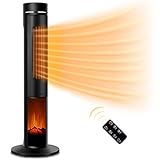Are you tired of shivering during those cold winter days and nights? Look no further than a ceramic heater! These compact, portable heaters are an excellent way to warm up your space without sacrificing style or comfort. But with so many options out there, where do you start? In this article, we’ll dive into the world of ceramic heaters, discussing how they work, the different types available on the market today, what to consider before purchasing one, and tips for setting it up in your home. So sit back and get ready to learn all about the best ceramic heaters consumer reports have to offer!
Top 10 Ceramic Heaters
*Note: Score is based on our AI score (Editor’s choice and rating).
What Is Ceramic Heater?
A ceramic heater is a type of electric heater that uses electricity to create heat. Unlike traditional heaters, which use metal coils or oil to generate heat, ceramic heaters utilize ceramic plates and aluminum baffles. These plates absorb the electricity and convert it into infrared radiation, which heats up the surrounding air.
Ceramic heaters are known for their energy efficiency as they consume less power than other types of space heaters. They also have safety features like overheat protection and cool-to-the-touch exteriors.
One reason why these heaters are so popular is that they come in various sizes and shapes; some resemble portable fans while others look like mini fireplaces or radiators. This means you can easily find one that fits your home decor or personal style.
Another advantage of using a ceramic heater is its quiet operation compared to other types of heating systems available on the market today. Plus, it’s easy to move around from room to room as needed since most models come with handles or wheels.
If you’re looking for an affordable yet efficient way to stay warm during those chilly months without breaking the bank on utilities bills – a ceramic heater might be just what you need!
How Does Ceramic Heater Work?
Ceramic heaters are among the most popular types of space heaters. They use an internal ceramic heating element, which is heated by electricity to produce heat energy. The ceramic material used in these heaters has high thermal conductivity, which means it can quickly and effectively transfer heat to the surrounding air.
A fan inside the heater then blows this hot air out into your room, rapidly raising its temperature. Ceramic heaters are designed with safety features like automatic shut-off switches that turn off the device if it overheats or tips over.
One of the main benefits of ceramic heaters is their efficiency. Because they work by directly heating up objects and people in a room rather than just warming up the air around them, they can be much more effective at providing warmth while using less energy than other types of space heaters.
Additionally, because they don’t rely on combustion to generate heat, ceramic heaters emit fewer harmful emissions and pose less risk for fires or carbon monoxide poisoning compared to gas-fired alternatives.
Understanding how a ceramic heater works can help you make an informed decision when selecting one for your home or office space.
The Different Types of Ceramic Heater
Ceramic heaters are a popular choice for home heating, and there are several types available on the market. One type is the ceramic space heater, which is portable and designed to heat small areas quickly. These heaters typically have an adjustable thermostat and safety features like overheat protection.
Another type of ceramic heater is the infrared ceramic heater. This type uses infrared technology to provide heat that feels more natural than other types of electric heaters. They also tend to be more energy-efficient than traditional space heaters.
Tower ceramic heaters are another option, and they’re designed to take up less floor space while still providing ample warmth. These models can often oscillate back and forth to distribute heat evenly throughout a room.
Some manufacturers make hybrid ceramic heaters that combine convection heating with radiant heating technology for maximum efficiency and comfort.
When considering which type of ceramic heater to purchase, it’s important to think about your specific needs in terms of size, portability, energy-efficiency, safety features and budget constraints.
Factors to Consider Before Buying Ceramic Heater
Before purchasing a ceramic heater, there are several factors to consider to ensure that you choose the most suitable model for your needs. First and foremost, it’s essential to determine the size of the area you want to heat as ceramic heaters come in various sizes with different heating capacities.
Secondly, check if the heater has adjustable temperature settings so that you can control its output depending on your comfort level. An ideal heater should also have safety features such as overheat protection and automatic shut-off functions.
Another factor is noise level; some models produce loud noises when operating which can be distracting or annoying. Therefore, it’s crucial to find a unit with quiet operation if you prefer silence while working or sleeping.
Additionally, portability is an important consideration for those who may need to move their heaters around frequently. Look for models with handles or wheels attached to make transportation easier.
Don’t forget about energy efficiency ratings; higher-rated units consume less power resulting in lower electricity bills. By keeping these factors in mind before buying a ceramic heater, you’ll end up choosing one that fits your requirements perfectly without any regrets later on!
Benefits of Using Ceramic Heater
Ceramic heaters have become increasingly popular in recent years due to the many benefits they offer. One of the main advantages is that they are energy-efficient, which means you can save money on your heating bill. They use ceramic plates to produce heat, which ensures that every corner of the room is evenly heated.
Another benefit of using a ceramic heater is that it produces clean and safe heat. Unlike other types of heaters, ceramic heaters don’t burn any fuels or emit fumes, making them an ideal choice for families with young children or pets. Additionally, they do not deplete oxygen levels in a room as some gas appliances do.
Ceramic heaters are also quite portable and easy to move around from one room to another since most models come equipped with handles for transportation. Furthermore, these types of heaters tend to be very quiet during operation and won’t disturb your sleep or work environment.
Unlike traditional space heaters that only last for one season before needing replacement parts or repairs; ceramic heaters typically last up to five years without requiring maintenance—making them an excellent investment for long-term home heating solutions!
The Pros and Cons of Ceramic Heater
Ceramic heaters have become a popular choice among homeowners due to their energy efficiency and safety features. However, like any appliance, they also come with both advantages and disadvantages.
One of the main benefits of ceramic heaters is that they can heat up a room quickly and efficiently without consuming too much energy. They are also safe to use because they do not get as hot as traditional space heaters, which reduces the risk of fires or burns.
Another advantage is that ceramic heaters are relatively quiet compared to other types of space heaters. This means you can place them in your bedroom or office without worrying about being disturbed by noise.
On the downside, ceramic heaters tend to be more expensive than other types of space heaters such as oil-filled radiators or fan-forced models. Additionally, while most models come with adjustable thermostats for temperature control, some may not include timers or remote controls for convenience.
It’s important to note that while ceramic heating elements are designed to last longer than traditional coils used in older models, they still require regular maintenance and cleaning.
If you’re looking for an efficient and safe way to heat your home during colder months without breaking the bank on electricity bills then a ceramic heater could be worth considering.
Tips For Setting Up Your Ceramic Heater
When setting up your ceramic heater, there are a few key tips to keep in mind. Firstly, it is important to choose the right location for your heater. You should place it on a stable surface and away from any flammable materials or furniture.
Next, be sure to read the instructions carefully before plugging in your heater. This will ensure that you set up the device correctly and avoid any potential safety hazards.
It is also crucial to make sure that the heater has enough space around it to properly circulate warm air throughout the room. Avoid placing objects too close to the unit as this can impede its effectiveness.
Remember to adjust the temperature settings according to your needs and preferences. If you only need a small amount of heat, consider setting it on low mode for energy efficiency.
Always turn off and unplug your ceramic heater when not in use or before leaving home for an extended period of time. By following these simple tips, you can enjoy safe and effective heating with your new ceramic heater!
FAQs
FAQs
Are ceramic heaters safe to use?
Yes, ceramic heaters are generally considered safe to use as long as they are used properly and according to the manufacturer’s instructions. However, it is always important to take necessary precautions such as keeping the heater away from flammable materials and never leaving it unattended.
How do I clean my ceramic heater?
To clean your ceramic heater, first turn off and unplug the device. Then using a soft brush or cloth, gently remove any dust or debris that may have accumulated on the surface of the heater. You can also use a vacuum cleaner with a soft brush attachment for more thorough cleaning.
Can I leave my ceramic heater running overnight?
It is not recommended to leave any type of space heater running overnight while you sleep due to potential fire hazards. It is best practice to turn off all space heaters before going bed.
What size of ceramic heater should I buy?
The size of your room will determine what size of ceramic heater you need. As a general rule, a 1500-watt unit will heat an average size room up to 150 square feet. If you have larger rooms or high ceilings, then you may need multiple units or a higher wattage model.
How much does it cost to run a ceramic heater?
The cost of operating a ceramic heater depends on several factors including its wattage rating and how often it is used. On average, most models cost around $0.15-$0.20 per hour based on energy consumption rates in North America.
Should I choose an oscillating or non-oscillating model?
This largely comes down personal preference but some people prefer oscillating models because they distribute heat more evenly throughout the room by moving back and forth whereas non-oscillating models only point in one direction
Conclusion
After considering all the factors and benefits of using ceramic heaters, it is clear that they are a great option for keeping your home warm during the colder months. They offer many advantages over other heating options, including energy efficiency, safety features, and versatility in terms of size and design.
When looking for the best ceramic heater to suit your needs, be sure to consider factors such as room size, power output, programmable settings, thermostat control and noise level. Furthermore,you may want to check Consumer Reports or any credible review website before making your purchase.
We hope this article has provided you with valuable insights on what to look for when choosing a ceramic heater and how they can benefit you. Stay warm this winter!
I’m Ella Andrews, owner of the website https://bestconsumerstips.com/
I give you valuable information about good products to help you choose the best product.











